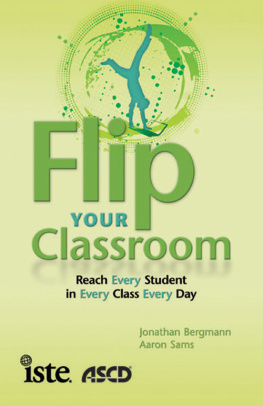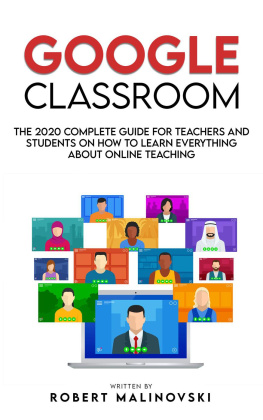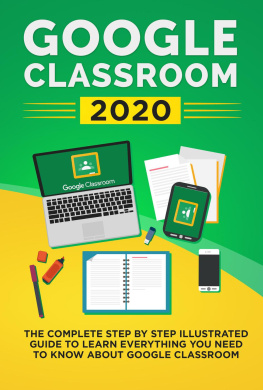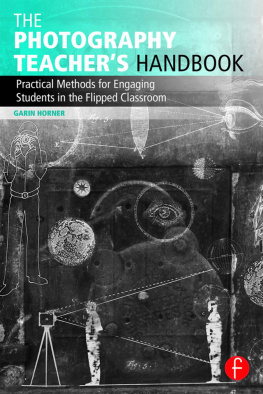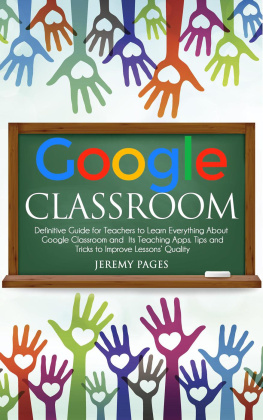Flip YOUR Classroom
Reach Every Student in Every Class Every Day
Jonathan Bergmann and Aaron Sams
2012 International Society for Technology in Education
World rights reserved. No part of this book may be reproduced or transmitted in any form or by any meanselectronic, mechanical, photocopying, recording, or by any information storage or retrieval systemwithout prior written permission from the publisher. Contact Permissions Editor: ; fax: 1.541.302.3780.
Director of Book Publishing: Courtney Burkholder
Acquisitions Editor: Jeff V. Bolkan
Production Editors: Lynda Gansel, Tina Wells
Production Coordinator: Emily Reed
Graphic Designer: Signe Landin
Copy Editor: Kristin Landon
Proofreader: Ann Skaugset
Cover Design, Book Design, and Production: Kim McGovern
Library of Congress Cataloging-in-Publication Data
Bergmann, Jonathan.
Flip your classroom : reach every student in every class every day / Jonathan Bergmann and Aaron Sams.
p. cm.
ISBN 978-1-56484-315-9 (pbk.)
1. Video tapes in education. 2. Individualized instruction. 3. TeachersTime management. 4. Homework. I. Sams, Aaron. II. Title.
LB1044.75.B47 2012
371.3352dc23
2011052647
First Edition
ISBN: 978-1-56484-315-9
Printed in the United States of America
Cover art: Dreamstime.com/Tiplyashina
ISTE is a registered trademark of the International Society for Technology in Education.
ASCD is a registered trademark of the Association for Supervision and Curriculum Development. ASCD product #112060

About ISTE
The International Society for Technology in Education (ISTE) is the trusted source for professional development, knowledge generation, advocacy, and leadership for innovation. ISTE is the premier membership association for educators and education leaders engaged in improving teaching and learning by advancing the effective use of technology in PK12 and teacher education.
Home to ISTEs annual conference and exposition, the ISTE leadership conference, and the widely adopted NETS, ISTE represents more than 100,000 professionals worldwide. We support our members with information, networking opportunities, and guidance as they face the challenge of transforming education. To find out more about these and other ISTE initiatives, visit our website at www.iste.org.
To learn more, go to www.iste.org or call (toll-free in the United States and Canada) 1.800.336.5191.
About ASCD
Founded in 1943, ASCD (formerly the Association for Supervision and Curriculum Development) is an educational leadership organization dedicated to advancing best practices and policies for the success of each learner. Our 150,000 members in more than 145 countries are professional educators from all levels and subject areassuperintendents, supervisors, principals, teachers, professors of education, and school board members.
Our nonprofit, nonpartisan membership association provides expert and innovative solutions in professional development, capacity building, and educational leadership essential to the way educators learn, teach, and lead.
To learn more, go to www.ascd.org/learnmore or call (toll-free in the United States and Canada) 1.800.933.ASCD (2723) or 1.703.578.0600.
About the Authors
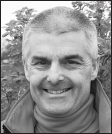
Jonathan Bergmann believes educators should ask one guiding question: What is best for my students in my classroom? To the best of his abilities he has done this in his 25 years as a high school science teacher. He received the Presidential Award for Excellence for Math and Science Teaching in 2002 and was named semi-finalist for the Colorado Teacher of the Year in 2010. He is currently the lead technology facilitator for the Joseph Sears School in Kenilworth, Illinois. He is the father of three teenagers and is happily married to the love of his life.

Aaron Sams has been an educator since 2000. He received the Presidential Award for Excellence in Math and Science Teaching in 2009 and cochaired the committee to revise the Colorado Science Academic Standards. He regularly turns off all his electronic devices to spend time with his wife and three children, and he highly recommends implementing unplugged Sundays for those who struggle to power down and spend time with the ones who matter most. Aaron holds a bachelor of science degree in biochemistry and a master of arts in education, both from Biola University, Colorado. He is currently a classroom science teacher in Woodland Park, Colorado.
Acknowledgment
Thanks to The Morgridge Family Foundation and Techsmith Corporation.
Dedication
For Kris and Kelsey
Foreword
One cool, crisp, typically gorgeous Colorado morning in the fall of 2010, I found myself driving into Woodland Park at the base of Pikes Peak. I was on my way to observe two teachers at Woodland Park High School whom I already knew online but hadnt ever had a chance to meet in person.
I first met Jon Bergmann and Aaron Sams online sometime in 2007. I dont recall exactly when and in what context anymore, but I began to read about the flipped approach they were using in their chemistry classes. As a former math teacher and current director of technology for my high school, this fit in nicely with my ongoing efforts to try to figure out how to best use technology to meet the needs of our teachers and students.
I began to read (and watch) more about this model and conversed with Jon and Aaron in various online settings trying to learn more about the advantagesand disadvantagesof this approach. Right from the start, it was clear that they didnt think they had all the answers. They were very upfront about what was working, and what wasnt working; about which aspects of their approach they thought were rock solid, and which aspects were weak (and they were constantly asking questions to try to improve these). In an age of silver bullets in education, this was refreshing.
Eventually Brian Hatak, one of the chemistry teachers at my high school, decided to try to implement a flipped classroom approach, and we began to try to figure out togetherwith lots of help from Jon and Aaron from afarhow best to do this. (Oh, how I wish wed had this book then.) Much like Jon and Aarons experience, we learned tremendously from both our successes and our challenges.
When in the fall of 2010 I returned to the classroom to pick up one section of algebra in addition to my tech director duties (a result of budget cuts), I knew I wanted to try to learn from their experiences to try to implement my own version of a flipped classroom approach. I asked if I could come down and visit their classrooms.

